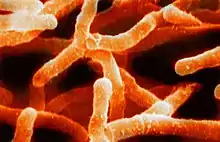Actinomycetales
The Actinomycetales is an order of Actinomycetota. A member of the order is often called an actinomycete. Actinomycetales are generally gram-positive and anaerobic and have mycelia in a filamentous and branching growth pattern. Some actinomycetes can form rod- or coccoid-shaped forms, while others can form spores on aerial hyphae. Actinomycetales bacteria can be infected by bacteriophages, which are called actinophages. Actinomycetales can range from harmless bacteria to pathogens with resistance to antibiotics.
| Actinomycetales | |
|---|---|
 | |
| Scanning electron micrograph of Actinomyces israelii. | |
| Scientific classification | |
| Domain: | Bacteria |
| Phylum: | Actinomycetota |
| Class: | Actinomycetia |
| Order: | Actinomycetales Buchanan 1917 (Approved Lists 1980)[1] |
| Type genus | |
| Actinomyces Harz 1877 (Approved Lists 1980) | |
| Families[2] | |
| |
Reproduction
Actinomycetales have 2 main forms of reproduction: spore formation and hyphae fragmentation. During reproduction, Actinomycetales can form conidiophores, sporangiospores, and oidiospores. In reproducing through hyphae fragmentation, the hyphae formed by Actinomycetales can be a fifth to half the size of fungal hyphae, and bear long spore chains.
Presence and associations
Actinomycetales can be found mostly in soil and decaying organic matter, as well as in living organisms such as humans and animals. They form symbiotic nitrogen fixing associations with over 200 species of plants, and can also serve as growth promoting or biocontrol agents, or cause disease in some species of plants. Actinomycetales can be found in the human urogenital tract as well as in the digestive system including the mouth, throat, and gastrointestinal tract in the form of Helicobacter without causing disease in the host. They also have wide medicinal and botanical applications, and are used as a source of many antibiotics and pesticides.
Antimicrobial properties
Many species of Actinomycetes produce antimicrobial compounds under certain conditions and growth media. Streptomycin, actinomycin, and streptothricin are all medically important antibiotics isolated from Actinomycetes bacteria.[3] Almost two-thirds of the natural antimicrobial drug compounds used currently are produced by different species of Actinomycetes.[4]
References
- Buchanan RE (1917). "Studies in the Nomenclature and Classification of the Bacteria: II. The Primary Subdivisions of the Schizomycetes". J Bacteriol. 2: 155–164. doi:10.1128/jb.2.2.155-164.1917. PMC 378699. PMID 16558735.
- Euzéby JP, Parte AC. "Actinomycetales". List of Prokaryotic names with Standing in Nomenclature (LPSN). Retrieved June 15, 2021.
- Waksman, Selman A.; Schatz, Albert; Reynolds, Donald M. (December 2010). "Production of antibiotic substances by Actinomycetes". Annals of the New York Academy of Sciences. 1213 (1): 112–124. doi:10.1111/j.1749-6632.2010.05861.x. PMID 21175680.
- Bentley, S. D.; Chater, K. F.; Cerdeño-Tárraga, A.-M.; Challis, G. L.; Thomson, N. R.; James, K. D.; Harris, D. E.; Quail, M. A.; Kieser, H.; Harper, D.; Bateman, A.; Brown, S.; Chandra, G.; Chen, C. W.; Collins, M.; Cronin, A.; Fraser, A.; Goble, A.; Hidalgo, J.; Hornsby, T.; Howarth, S.; Huang, C.-H.; Kieser, T.; Larke, L.; Murphy, L.; Oliver, K.; O'Neil, S.; Rabbinowitsch, E.; Rajandream, M.-A.; Rutherford, K.; Rutter, S.; Seeger, K.; Saunders, D.; Sharp, S.; Squares, R.; Squares, S.; Taylor, K.; Warren, T.; Wietzorrek, A.; Woodward, J.; Barrell, B. G.; Parkhill, J.; Hopwood, D. A. (9 May 2002). "Complete genome sequence of the model actinomycete Streptomyces coelicolor A3(2)". Nature. 417 (6885): 141–147. doi:10.1038/417141a. PMID 12000953.